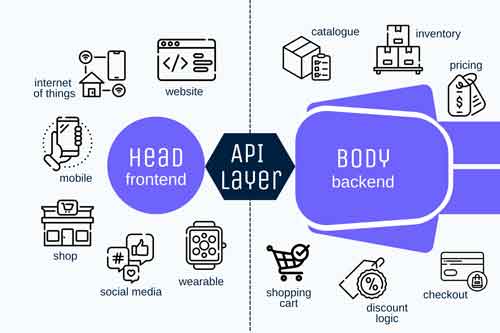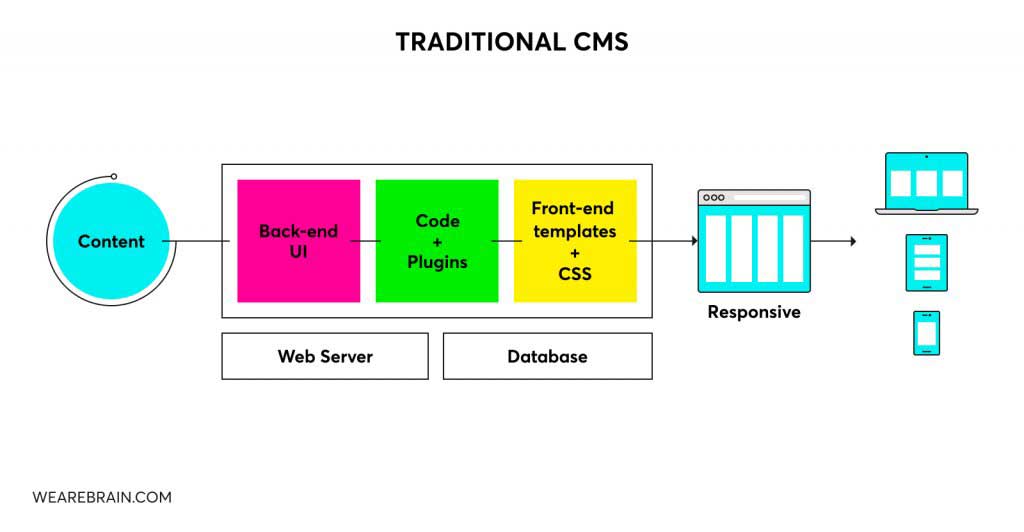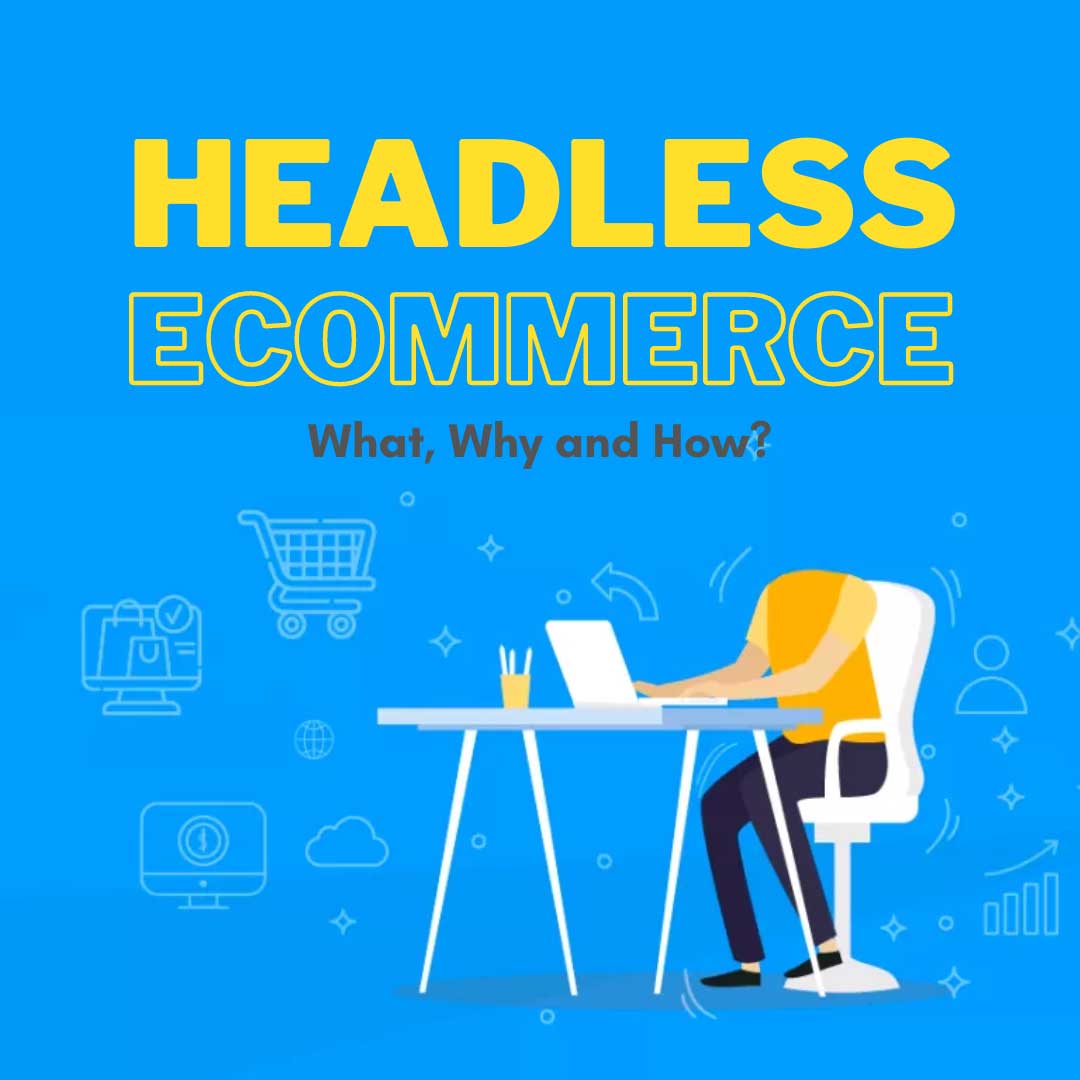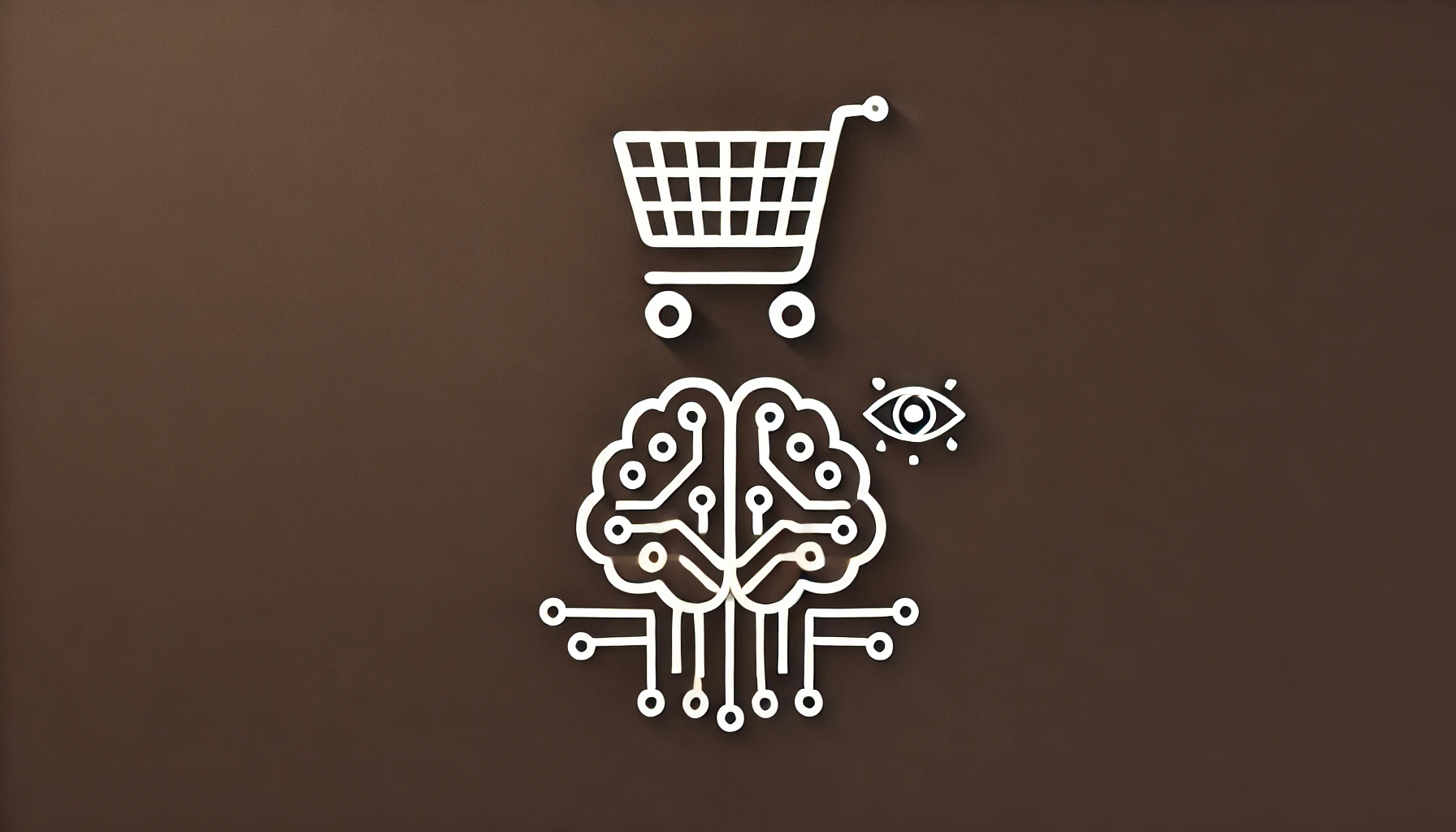Headless e-commerce is a relatively new concept in the world of online retail that is quickly gaining popularity among businesses of all sizes. In simple terms, headless e-commerce refers to the separation of the front-end and back-end of an ecommerce platform, allowing for greater flexibility and scalability.
Traditionally, ecommerce platforms have been monolithic, meaning that the front-end and back-end of the platform were tightly integrated. This made it difficult to make changes or updates to the front-end without affecting the back-end, and vice versa. In contrast, headless ecommerce decouples the front-end and back-end, allowing businesses to make changes to one without affecting the other.
Let dive deep into headless eCommerce.
What is Headless Commerce?
Headless commerce is a modern approach to eCommerce that involves separating the front-end, or “head,” of an online store from the back-end.
The front-end is the portion of the website that customers see and interact with, such as the homepage, product pages, and shopping cart. The back-end, on the other hand, is responsible for managing the underlying functionality of the store, such as checkout, payments, subscriptions, and inventory management.

Image credit – Hypotenuse AI
By decoupling the front-end from the back-end, headless commerce allows for greater flexibility and scalability. The front-end can be built using any technology or framework and can be easily updated without affecting the back-end. Additionally, headless commerce enables the creation of unique and personalized customer experiences across multiple channels or touchpoints, such as web, mobile, and voice assistants.
By utilizing a headless CMS, you can store your eCommerce data in one central location and then select the specific touchpoints (or heads) where you want to display it, enabling you to deliver a consistent and seamless omnichannel experience to customers.
Why is the world going headless?
Headless solutions allow businesses to adopt an omnichannel approach. Omnichannel is a modern eCommerce strategy that involves making products and services available to customers across multiple channels, such as social media, mobile apps, and IoT devices.
By using a headless content management system (CMS), businesses can store their eCommerce data in one place and then choose the touchpoints where they want to display it.
This helps businesses to deliver a consistent and seamless experience to customers across all channels.
However, adopting an omnichannel approach can be expensive for some businesses as it requires a team of experienced developers. To adopt an omnichannel approach without spending too much, businesses can use headless solutions. These solutions provide a headless CMS and a headless solution that allows businesses to decouple their eCommerce data from one touchpoint to display across different channels.
The world is moving towards headless architecture because of the exponential growth of IoT devices and the changing behavior of customers, particularly younger generations.
As per the Millennial Shopping Report 2019, a survey was conducted among young individuals. The survey focused on whether they use voice assistance for shopping, such as product search and product reviews. The results showed that 45% of those surveyed stated that they use voice assistants for their online purchases. This highlights the growing importance of voice-controlled devices, such as Google Home and Amazon Echo, in e-commerce.
But the headless eCommerce is not only for Google Home Assist or Amazon Echo. It helps you target the different screens like the smart wearable devices (through Augmented Reality and Virtual Goggles) which are becoming increasingly popular.
This means that if a website wants to stay relevant and successful in the future, it must be able to connect and deliver a seamless experience across different channels and platforms. With headless architecture, businesses can independently develop and deploy the front-end and back-end, resulting in faster and more efficient updates, and a better user experience.
How does headless commerce work?
Headless eCommerce is a modern approach to building online stores that leverages an application programming interface (API) to deliver content. An API is a software intermediary that allows the front-end and back-end of an online store to communicate with each other.
When a customer interacts with a headless eCommerce store, the front-end sends an API request to the back-end.
For example, when a customer purchases a product on their smartphone, the front-end triggers an API call which is then sent to the back-end order management system. The back-end processes the order and sends a response back to the front-end, which the customer sees as an update on the order status.
This process is the same regardless of the device or channel that the customer is using to access the store. The headless system manages all API requests and ensures that the back-end interacts with them efficiently.
The front-end of a headless eCommerce site only displays the necessary information to the customer and does not show what is happening in the back-end. The way that information is displayed depends on the chosen channel and its layout, providing flexibility in designing and deploying the online store.
Headless eCommerce technology provides eCommerce brands with flexibility and opportunities to create an omnichannel experience for their customers. By using headless technology, brands can create a seamless shopping experience across different devices and channels, providing a consistent and personalized experience to customers.
Statistics of Headless eCommerce
Headless eCommerce is a rapidly growing trend among businesses looking to improve customer experience and meet the expectations of modern consumers. Headless commerce provides businesses with the ability to create user-friendly websites that are flexible and customizable.
The statistics for headless eCommerce in 2022 reflect this growing trend:
- 61% of retailers have either already implemented headless commerce or plan to shortly.
- 62% of companies believe that headless eCommerce can significantly increase engagement and conversions.
- 92% of businesses believe that it is easier to deliver a powerful digital experience with headless commerce platforms.
- 68% of companies that want to go headless would use the services of headless eCommerce platforms.
- Headless technologies have raised over $1.65 billion in funding.
To stay competitive in today’s digital landscape, it is not enough to simply have native mobile apps, a presence on social media, or a traditional eCommerce platform. Businesses must leverage headless commerce to expand their reach across multiple customer touchpoints and deliver an omnichannel experience to customers.
Traditional eCommerce platforms vs. headless eCommerce platforms
Headless eCommerce platforms are becoming increasingly popular among businesses due to their flexibility and scalability.
The main difference between headless and traditional eCommerce platforms is how they handle the separation of the front-end and back-end of the website.
Traditional eCommerce, also known as monolithic, is an all-in-one solution where the website’s back-end and front-end are tightly linked together. Any changes made on the back-end will directly impact the front-end and vice versa. This can make it difficult for developers to make changes to the website without causing disruptions to the overall functionality.
For example, if a developer wants to make a design change on the front-end, they may inadvertently break a critical back-end function like payment processing. This can lead to a lot of frustration and wasted time trying to fix the problem.
On the other hand, headless eCommerce separates the back-end from the front-end, allowing developers to make changes to the front-end without worrying about how it will impact the back-end. The back-end and front-end communicate through application programming interfaces (APIs), which allows for updates to be made without disrupting the front-end.

Image Credit – Coredna.com
This separation of concerns allows for greater flexibility and scalability, as developers can make changes to the front-end without worrying about how it will impact the back-end. Additionally, headless eCommerce allows for a more personalized user experience, as businesses can use different front-end technologies to create unique experiences for different devices or customer segments.
In summary, headless eCommerce provides businesses with greater flexibility and scalability, allowing them to make changes to the front-end without disrupting the back-end. This makes it a popular choice among businesses looking to improve their online presence.
The drawbacks of a traditional eCommerce platform
When choosing between a traditional or headless commerce platform, it is important to consider the specific needs of your business. While traditional eCommerce platforms have been the norm for many years, headless commerce has become increasingly popular due to its flexibility and scalability.

Image Credit – Wearebrain.com
One of the main drawbacks of traditional eCommerce is the limited customization options available. Adding customization to a traditional eCommerce site can be difficult, as it often requires workarounds and extensive testing to ensure that nothing breaks as a result of the changes.
In contrast, the headless architecture allows for limitless customization options, giving businesses more freedom to create a unique look and feel for their website.
Another drawback of traditional eCommerce is the lack of options to create a rich customer experience. Consumers today demand personalization, and traditional eCommerce platforms often have limitations in their front-end themes, making it difficult to improve personalization.
Headless commerce, on the other hand, allows for a more personalized user experience, as businesses can use different front-end technologies to create unique experiences for different devices or customer segments.
In addition, traditional eCommerce can make it difficult to integrate new software as new technologies are released. Developers may have to find workarounds to integrate new tools, which can be time-consuming and frustrating. With headless commerce, it is easier to integrate new software and technologies.
Finally, traditional eCommerce can have problems with optimization, as the monolithic architecture is rigid. This can make it challenging to optimize the website for different devices, resulting in slow loading times, missing buttons, and distorted drop-down menus for customers using different devices. This can lead to a poor user experience, causing customers not to return. Headless commerce can overcome these issues with optimization.
In conclusion, the choice between a traditional or headless commerce platform depends on the specific needs of your business. Businesses should consider the drawbacks of traditional eCommerce before making a decision, such as limited customization options, lack of options to create a rich customer experience, difficulties with integrating new software, and problems with optimization.
Headless commerce can overcome these issues and provide businesses with greater flexibility and scalability.
Benefits of headless eCommerce
The headless eCommerce architecture offers several key advantages, including:
- Flexibility in the ability to easily integrate and use new technologies
- Enhanced customization options to create a unique look and feel for the website
- Improved personalization to create a more personalized user experience
- Increased speed in the ability to make changes and updates quickly and efficiently
We’ll explain each of them in detail below.
Flexibility & Scalability
In headless commerce, the front-end and back-end are separated, allowing for greater flexibility and independence for developers. This means that changes and updates can be made without disrupting the entire website. This also allows for other departments, such as marketing teams, to make updates and changes without relying on the IT team.
For example, with headless eCommerce, marketing teams can launch a promotional campaign without the help of developers. They can update content or banners independently, without the need for complete system reconfiguration. This flexibility is one of the key benefits of headless eCommerce. Changes such as adding new checkout flow or subscription plans can be easily implemented due to the decoupled architecture.
Another benefit of headless eCommerce is the ability to easily scale and adapt to changing business needs. With a traditional eCommerce platform, businesses often find themselves locked into a specific technology stack or architecture, making it difficult to scale or adapt to changing business needs.
With headless eCommerce, businesses can easily scale and adapt to changing business needs, such as a sudden increase in traffic or the introduction of new product lines, without having to completely overhaul their entire eCommerce platform.
Easy Integrations and Enhanced customization
One of the key benefits of headless eCommerce is the ability to easily integrate with other systems and platforms. With a traditional e-commerce platform, businesses are often limited to the features and functionality built into the platform.
With headless eCommerce, businesses can easily integrate with other systems and platforms, such as CRM, ERP, and marketing automation systems, to create a truly integrated and seamless customer experience.
Headless commerce allows for a more flexible approach to integrations. Brands can easily add new software and features to improve their online store. The main advantage of headless commerce is the ability to choose which integrations to implement.
A headless commerce platform does not require you to use all the tools it supports, instead, you can choose which software is best for your business.
Improved personalization
Headless commerce allows for more experimentation with personalization without affecting the performance of your online store.
For example, new personalization features can be tested and launched in the back-end without disrupting customers on the front-end. This allows for the testing and implementation of new methods to create a personalized customer experience, such as personalized content based on demographics or search history.
Headless commerce is designed to create a personalized shopping and browsing experience across multiple channels, while traditional CMS like WordPress has limitations in personalization capabilities.
Headless CMS provides more flexibility in terms of personalization by separating content from the back-end, making it reusable across different channels, streamlining content localization, and integrating with other tools.
Increased Speed
Speed is an important factor in user experience. Customers will leave your online store if it takes too long to load. Fast loading times create a smooth shopping experience, and they also affect your search engine ranking.
Headless eCommerce platforms deliver fast loading times. This technology uses APIs to deliver content on any device, resulting in faster delivery of content to customers than traditional commerce platforms. With a headless eCommerce platform, you don’t have to worry about speed issues.
Limitations of headless eCommerce
One of the key challenges of headless ecommerce is the need for a dedicated team with the technical expertise to manage and maintain the platform. With a traditional ecommerce platform, businesses often have access to a dedicated support team that can help with any issues or problems that arise.
With headless ecommerce, businesses need to have a dedicated team with the technical expertise to manage and maintain the platform, as well as the ability to troubleshoot and resolve any issues that may arise.
Another challenge of headless ecommerce is the need for a strong content management system (CMS) to manage and maintain the front-end of the platform. With a traditional ecommerce platform, businesses often have access to a built-in CMS that makes it easy to manage and maintain the front-end of the platform.
With headless ecommerce, businesses need to have a strong CMS in place to manage and maintain the front-end of the platform, as well as the ability to integrate with other systems and platforms.
Other headless eCommerce limitations to keep in mind are:
- Complexity: The decoupled nature of headless eCommerce can lead to increased complexity in development and maintenance. Developers need to have a solid understanding of APIs and how to integrate them with different systems.
- Cost: Implementing a headless eCommerce solution may require additional costs for integrating different systems and APIs.
- Limited support: Not all eCommerce platforms offer headless options, and those that do may have limited support and documentation.
- Lack of built-in features: Headless eCommerce platforms are typically more flexible, but they lack the built-in features and functionalities that traditional eCommerce platforms offer. This means that additional development and integration are required to add these features.
- Limited front-end customization: While headless eCommerce allows for more flexibility in the back-end, it can also limit front-end customization options as developers need to integrate front-end components separately.
- Lack of standardization: As headless eCommerce is relatively new, there is a lack of standardization in the industry. This makes it difficult to find compatible tools and systems.
Tips for choosing a headless eCommerce platform
Here are some tips for choosing a headless eCommerce platform:
- Scalability: Make sure the platform can handle your current and future needs. Consider whether it can handle a large number of products and customers, as well as handle any potential traffic spikes.
- Security: Headless eCommerce platforms handle sensitive customer data, so security should be a top priority. Ensure that the platform has robust security measures in place, such as encryption and two-factor authentication.
- Integration: Check that the platform can integrate with your existing systems and third-party tools, such as payment gateways, CRM systems, and analytics tools.
- Support and resources: Look for a platform that offers excellent support and resources, such as documentation, tutorials, and community forums.
- Customizability: A headless eCommerce platform should offer flexibility, so you can create a unique customer experience. Check if the platform allows you to customize the front-end and back-end of your store as per your requirements.
- Functionality: Consider the features and functionalities that are important for your business such as inventory management, order management, and shipping options.
- Cost: Compare the pricing plans and services of different headless eCommerce platforms to find the best value for your business
Headless eCommerce Technologies
Headless ecommerce is an emerging trend in the world of online retail, and several technologies are currently trending in this area. Some of the most popular ones are:
- Progressive Web Apps (PWA): PWAs are web apps that use modern web technologies to deliver an app-like experience to users. They are becoming increasingly popular in headless ecommerce as they allow businesses to deliver a seamless user experience across all devices, including smartphones and tablets.
- Artificial Intelligence (AI) and Machine Learning (ML): AI and ML are being used in headless ecommerce to personalize the customer experience and improve the effectiveness of marketing campaigns. This is a trending topic as it allows businesses to deliver a more personalized experience to customers and improve their overall customer engagement.
- GraphQL: GraphQL is a query language that is becoming increasingly popular in headless commerce. It allows businesses to easily retrieve data from multiple sources and create a seamless customer experience.
- Microservices Architecture: Microservices architecture is an architectural pattern that allows businesses to break down a monolithic application into smaller, independent services that can be developed, deployed, and scaled independently. This is a trending topic as it allows businesses to improve the scalability and maintainability of their headless e-commerce systems.
- Headless Commerce: This is a trending topic as it allows businesses to separate the front-end and back-end of their ecommerce platform, allowing for greater flexibility and scalability. This approach allows businesses to easily integrate with other systems and platforms, and easily scale and adapt to changing business needs.
- JAMstack: JAMstack is a web development architecture that uses Javascript, APIs, and Markup, and is becoming increasingly popular in headless ecommerce. It allows businesses to build fast, secure, and scalable ecommerce websites and apps.
- Cloud-Native: Cloud-native is an approach to building and running applications and services that leverage cloud computing technologies. This is a trending topic as it allows businesses to easily scale and adapt to changing business needs, and take advantage of the many benefits of cloud computing, such as cost savings, scalability, and improved security.
- Decoupled CMS: Decoupled CMS is a form of headless CMS in which the front-end and back-end of a website or application are separated, allowing for greater flexibility and scalability. This is a trending topic as it allows businesses to easily integrate with other systems and platforms, and easily scale and adapt to changing business needs.
Best headless eCommerce platforms for your next project
There are several headless eCommerce platforms available in the market, and the best one for your next project will depend on your specific needs and requirements. Some popular headless eCommerce platforms include:
- Shopify Plus: A fully-managed, cloud-based platform that allows you to build an online store quickly and easily.
- BigCommerce: A scalable and flexible platform that supports multiple languages and currencies, and offers a wide range of integration options.
- Magento: A popular open-source eCommerce platform that supports headless architecture and offers a wide range of customization options.
- Salesforce Commerce Cloud: A cloud-based platform that provides a wide range of features and tools to create personalized shopping experiences.
- SAP Commerce Cloud: A platform that offers a wide range of features and tools to create personalized shopping experiences, and it is built on top of the SAP Hybris technology.
Ultimately, the best headless eCommerce platform for your next project will depend on your specific business needs and requirements. It’s recommended to research and compare different options before making a final decision.
In conclusion
Headless e-commerce is a new concept that allows for greater flexibility and scalability in ecommerce platforms. It separates the front-end and back-end of an ecommerce platform, allowing businesses to make changes to one without affecting the other. Headless ecommerce offers several benefits such as easy integration with other systems and platforms, easy scalability, and the ability to create a seamless customer experience.
However, it requires a dedicated team with technical expertise to manage and maintain the platform, as well as a strong content management system to manage the front-end.
Despite the challenges, headless ecommerce is quickly becoming the preferred choice for businesses of all sizes. The ability to easily integrate with other systems and platforms, easily scale and adapt to changing business needs, and the ability to create a truly integrated and seamless customer experience, make headless ecommerce a powerful and flexible ecommerce solution.
For more information on headless commerce please contact our eCommerce website development company in India.
Whatsapp/Call- +91-8447380262
US Phone number – +1- 806-402-8343
Email – inquiry@icowebsolutions.com





